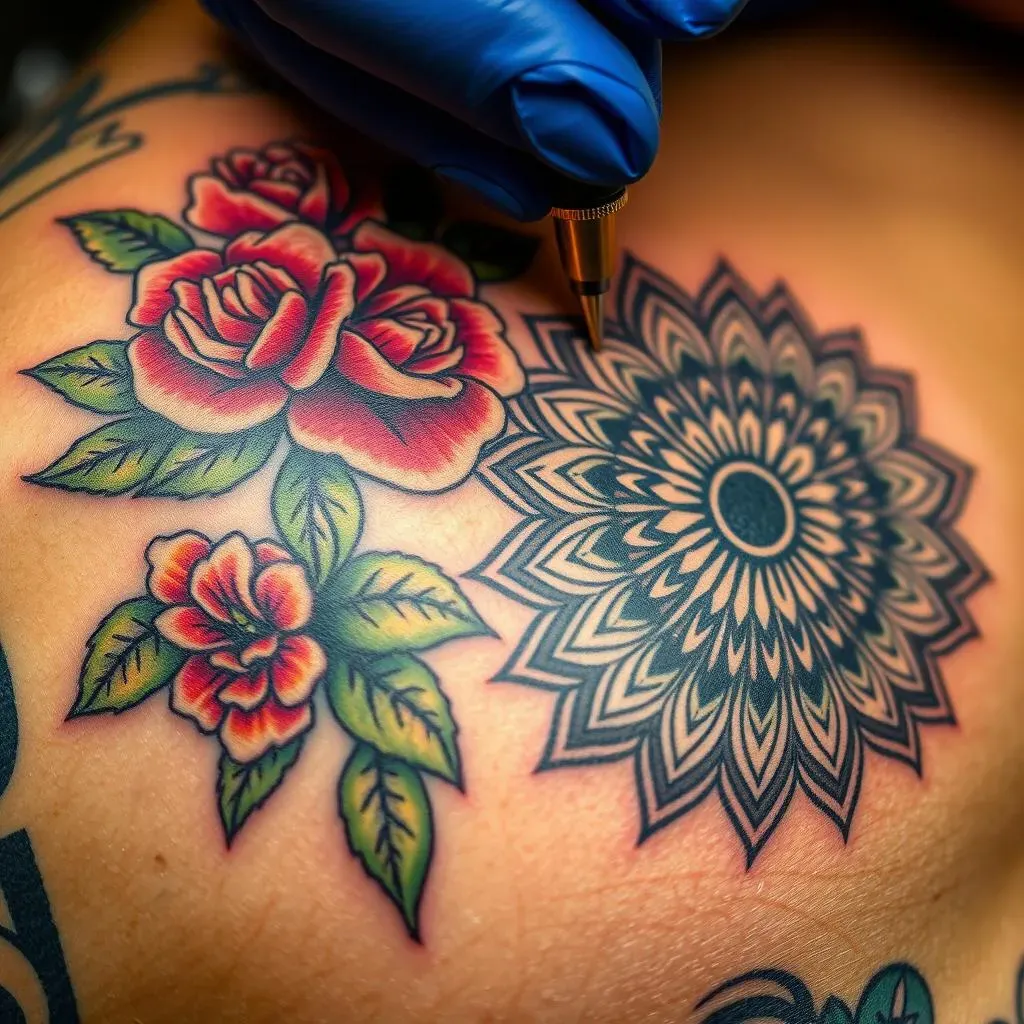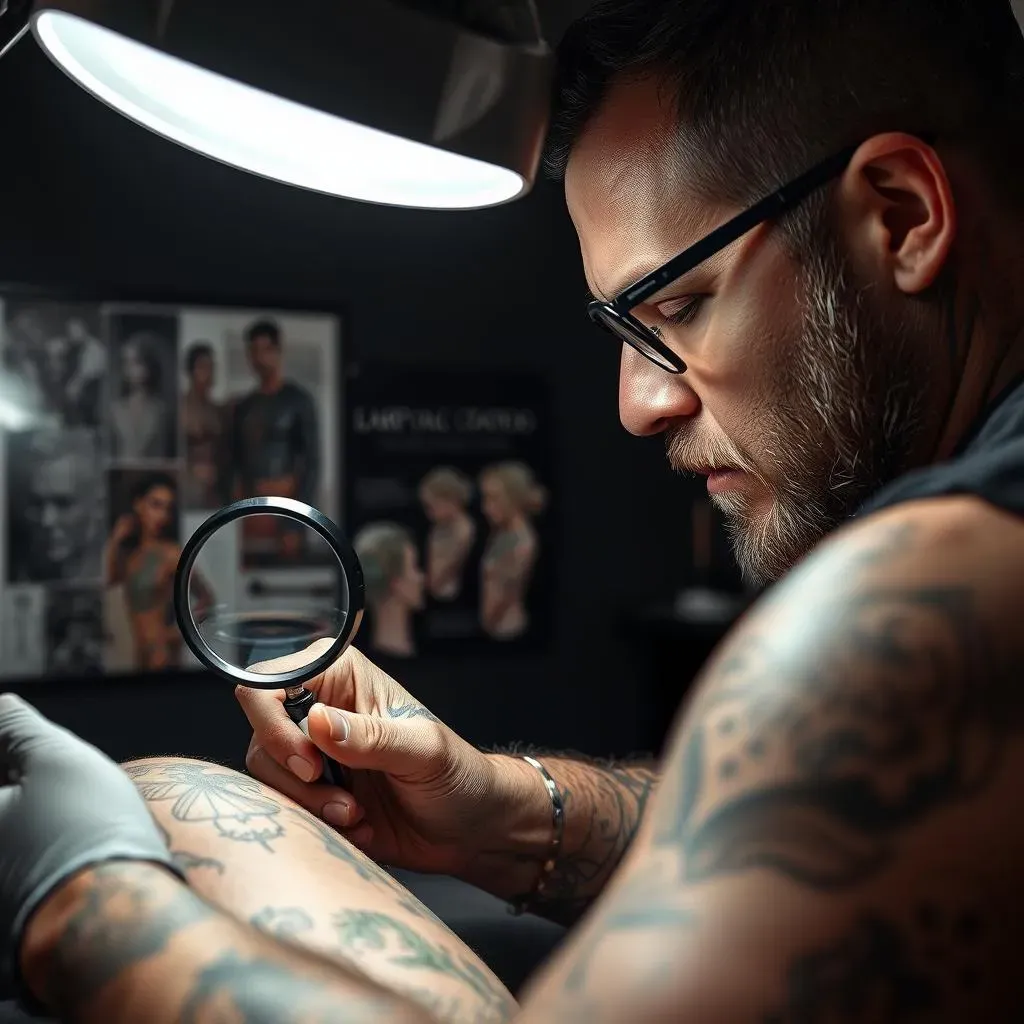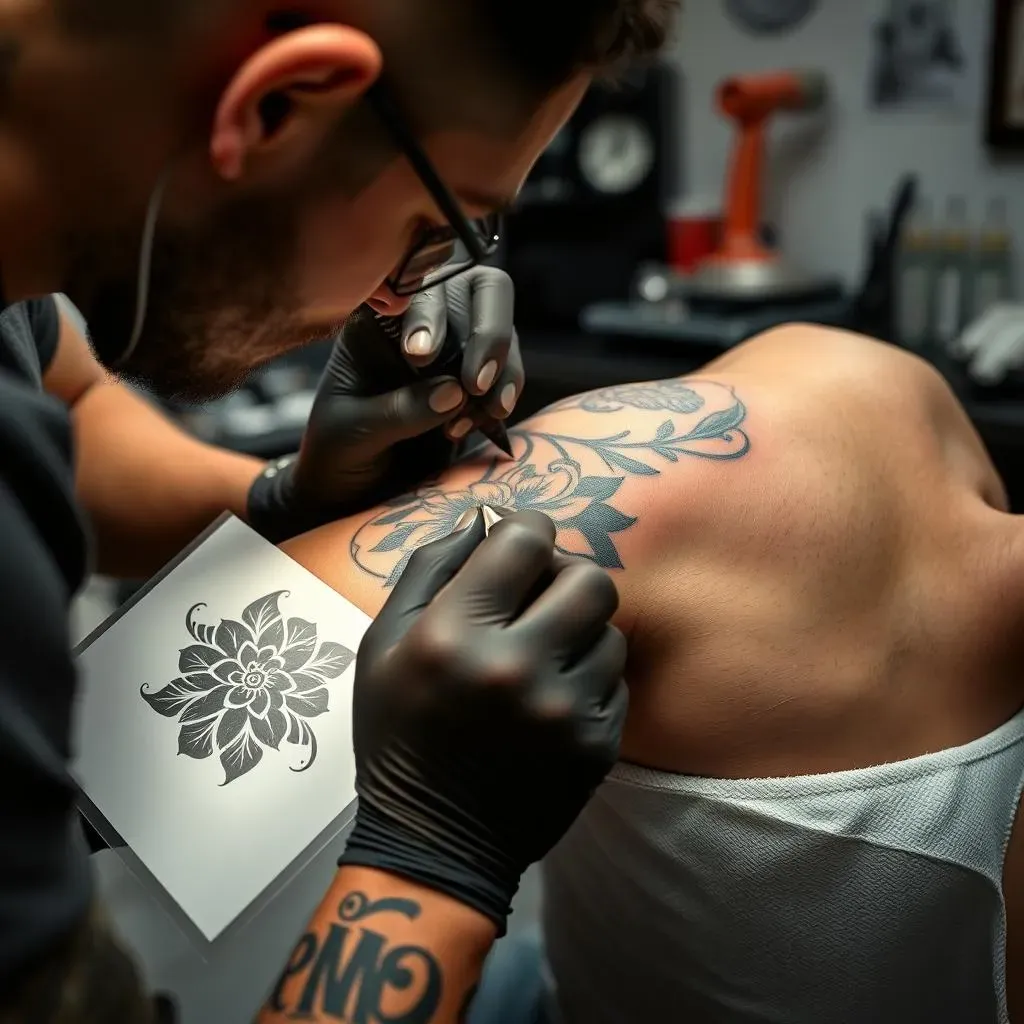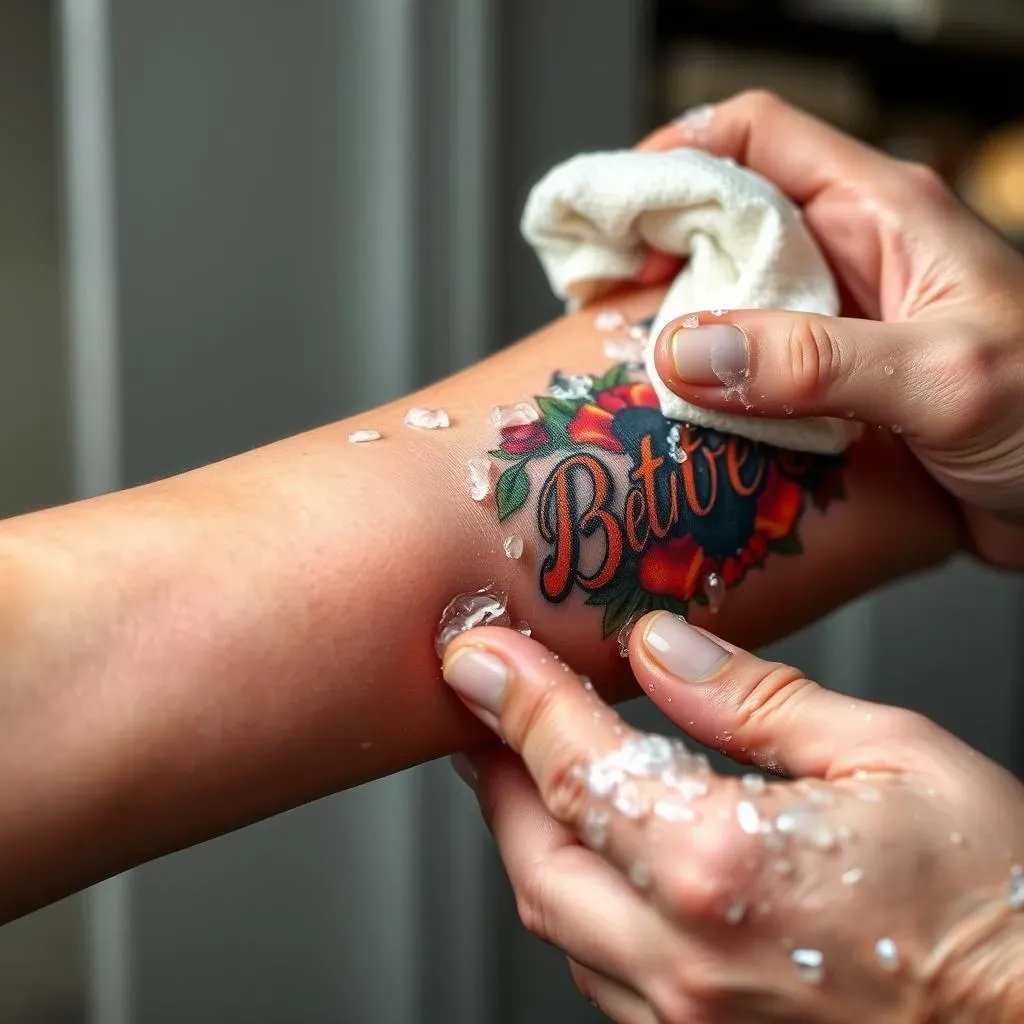Table of Contents
Got a tattoo you regret? You're not alone. Maybe it's a faded memory of a wild night, a symbol that no longer resonates, or simply a design that didn't age well. Whatever the reason, cover up tattoo designs offer a fantastic solution: a chance to transform unwanted ink into a piece of art you'll love. This guide dives deep into the world of tattoo cover-ups, exploring creative ideas, expert advice, and essential tips for achieving stunning results. We'll walk you through understanding why and when a cover-up is the right choice, showcasing the most popular and effective designs, and guiding you on how to select a skilled artist who specializes in these transformations. Plus, we'll demystify the cover-up process itself, and provide crucial aftercare instructions to ensure your new tattoo looks its best for years to come. Get ready to say goodbye to tattoo regret and hello to a beautiful, confidence-boosting work of art.
Understanding Cover Up Tattoo Designs: Why and When?
Understanding Cover Up Tattoo Designs: Why and When?
#1: Reasons for Considering a Cover Up
Let's face it, tattoos are pretty permanent, but sometimes our tastes aren't. There are tons of reasons why someone might want to explore cover up tattoo designs. Maybe that youthful impulse decision isn't quite fitting your current vibe. Perhaps the tattoo artist wasn't exactly a master of their craft, and the result is less than stellar. Or, life happens, and a symbol that once held deep meaning might now bring up unwanted memories. Whatever the reason, it's valid.
Beyond personal preferences, tattoos can also fade, blur, or distort over time, losing their original appeal. Weight fluctuations, sun exposure, and even just the natural aging process can impact the appearance of your ink. A cover-up can breathe new life into a tired tattoo, restoring vibrancy and clarity or completely transforming it into something fresh and exciting. It's all about taking control and owning your body art.
#2: Assessing Your Tattoo for Cover Up Potential
Not every tattoo is a prime candidate for a cover-up. Several factors influence the success of the process. The size, color, and density of the existing tattoo all play a role. Darker, larger tattoos generally require more creative solutions and may limit your design options. Lighter inks, on the other hand, are often easier to conceal.
Scarring can also present a challenge. Raised or textured skin can affect ink absorption and potentially impact the final result. A skilled artist can work with minor scarring, but significant damage might require alternative approaches, such as laser tattoo removal to lighten the existing ink before attempting a cover-up. It's all about a realistic assessment and open communication with your chosen artist.
Factor | Impact on Cover Up |
|---|---|
Dark Ink | Requires darker, bolder cover-up designs |
Large Size | Limits design options, may need larger cover-up |
Scarring | Can affect ink absorption and design |
Faded Ink | Easier to cover, more design flexibility |
Top Cover Up Tattoo Designs and Ideas
Top Cover Up Tattoo Designs and Ideas
#1: Nature-Inspired Cover Up Tattoo Designs
When it comes to cover up tattoo designs, nature provides endless inspiration. Think sprawling florals, like roses or peonies, with their intricate petals offering ample coverage. A vibrant, detailed tree with winding roots can effectively conceal unwanted ink while symbolizing growth and resilience. Even aquatic themes, such as koi fish or coral reefs, can be masterfully employed to transform an old tattoo into a stunning new piece. The key is to choose designs with plenty of detail and shading to effectively camouflage the original artwork.
Consider the story you want to tell with your new tattoo. Are you looking for something bold and eye-catching, or something more subtle and symbolic? A skilled artist can help you translate your vision into a nature-inspired masterpiece that not only covers up your old tattoo but also reflects your personal style and values.
#2: Abstract and Geometric Cover Up Tattoo Designs
For those seeking a more modern or edgy aesthetic, abstract and geometric cover up tattoo designs offer a unique and visually striking option. Bold geometric patterns, like mandalas or tessellations, can effectively obscure unwanted ink with their intricate lines and shapes. Abstract designs, with their free-flowing forms and vibrant colors, allow for a more artistic and unconventional approach to cover-ups.
The beauty of abstract and geometric designs lies in their versatility. They can be customized to fit any size or shape, and they can be adapted to conceal a wide range of tattoo styles. Plus, they offer a fantastic opportunity to incorporate negative space and create a visually dynamic and captivating piece of art.
Design Style | Coverage Effectiveness | Aesthetic |
|---|---|---|
Floral | High (due to detail and shading) | Feminine, Natural, Romantic |
Geometric | Medium to High (depending on complexity) | Modern, Edgy, Abstract |
Tribal | High (bold lines and dark ink) | Strong, Symbolic, Traditional |
Abstract | Medium (requires strategic placement) | Artistic, Unique, Unconventional |
#3: Bold and Dark Cover Up Tattoo Designs
Sometimes, the best way to cover up an old tattoo is to go bold and dark. Traditional tribal designs, with their thick lines and solid black ink, are highly effective at concealing unwanted artwork. Blackwork tattoos, which utilize large areas of black ink, can completely transform an old tattoo into a powerful and striking statement piece. This approach is particularly useful for covering up tattoos with dark or saturated colors.
However, it's important to note that bold and dark cover-ups may limit your future tattoo options. Once you've committed to a large area of black ink, it can be challenging to add lighter colors or intricate details later on. Therefore, it's crucial to carefully consider your long-term tattoo goals before opting for this approach. A consultation with a skilled tattoo artist can help you weigh the pros and cons and determine if a bold and dark cover-up is the right choice for you.
Choosing the Right Artist for Your Cover Up Tattoo
Choosing the Right Artist for Your Cover Up Tattoo
#1: Specialization Matters
Not all tattoo artists are created equal, especially when it comes to cover up tattoo designs. It's crucial to seek out an artist who specializes in cover-ups, rather than just any artist. Cover-up work requires a unique skill set and understanding of color theory, design principles, and how ink interacts with existing tattoos. An artist with extensive experience in cover-ups will be better equipped to assess your tattoo, recommend appropriate designs, and execute the cover-up effectively.
Think of it like this: you wouldn't go to a general practitioner for heart surgery, right? Similarly, you want an artist with specialized knowledge and a proven track record in the specific area of cover-up tattoos. Check out their portfolio, read reviews, and don't hesitate to ask questions about their experience and approach to cover-up work. It's an investment in your skin, so do your research!
#2: Portfolio Power
Speaking of portfolios, this is where the rubber meets the road. A strong portfolio is the best indicator of an artist's skill and experience in cover up tattoo designs. Look for before-and-after photos that clearly showcase the artist's ability to transform unwanted tattoos into stunning new pieces. Pay attention to the types of designs they specialize in. Do they excel at floral cover-ups, geometric designs, or bold blackwork? Make sure their style aligns with your vision for your new tattoo.
Don't just focus on the "after" photos. The "before" photos are just as important. They give you insight into the types of tattoos the artist has successfully covered up in the past. Has the artist successfully covered up tattoos with similar colors, sizes, and styles as yours? This will give you confidence in their ability to tackle your specific cover-up challenge.
Portfolio Element | Importance |
|---|---|
Before-and-After Photos | Demonstrates cover-up skill and effectiveness |
Variety of Styles | Shows versatility and adaptability |
Similar Tattoo Types | Indicates experience with similar cover-up challenges |
Overall Quality | Reflects the artist's attention to detail and artistry |
#3: Consultation is Key
Once you've identified a few potential artists, schedule a consultation. This is your opportunity to discuss your ideas, ask questions, and get a professional assessment of your tattoo's cover-up potential. A good artist will be honest and upfront about what's possible, and they'll work with you to develop a design that effectively conceals the old tattoo while meeting your aesthetic preferences.
During the consultation, be prepared to discuss your tattoo history, any allergies or skin conditions you may have, and your pain tolerance. The artist will also want to see your tattoo in person to assess its size, color, and location. Don't be afraid to ask for references or to see examples of their work in person. A reputable artist will be happy to provide this information and answer any questions you may have. Trust your gut. If you don't feel comfortable with an artist, move on to the next one. Finding the right artist is essential for a successful and satisfying cover-up tattoo experience.
The Cover Up Tattoo Process: What to Expect
The Cover Up Tattoo Process: What to Expect
#1: The Consultation Deep Dive
so you've picked your artist – awesome! Now comes the consultation, which is way more than just a quick chat. This is where you really hash out the details. Expect your artist to thoroughly examine your existing tattoo, considering its size, colors, and the ink density. They'll also want to understand your vision for the cover-up: what kind of style are you after? What are your must-have elements? Don't be shy – bring reference photos, sketches, or anything that helps communicate your ideas clearly.
The artist will then explain what's realistically achievable, given the limitations of the existing tattoo. They might suggest design adjustments or even recommend a few laser tattoo removal sessions to lighten the old ink, especially if it's very dark or heavily saturated. This isn't a sales pitch; it's about ensuring the best possible outcome for your cover-up. Be prepared to collaborate and trust their expertise – they've seen it all before!
#2: The Stencil Application
Once you've finalized the design, the artist will create a stencil – a temporary outline of the tattoo that's applied to your skin. This allows you to see exactly how the cover-up will fit over the existing tattoo and make any necessary adjustments before the tattooing begins. The artist will carefully position the stencil, ensuring that it effectively camouflages the old ink and complements your body's natural contours. This is your last chance to tweak the design, so speak up if anything doesn't look quite right.
Don't be afraid to ask the artist to move the stencil around or make minor alterations. A few small adjustments at this stage can make a huge difference in the final result. Remember, this is your tattoo, and you want to be completely happy with it. Once the stencil is in place, the artist will clean and shave the area (if necessary) to prepare your skin for the tattooing process.
Process Step | Description | Key Considerations |
|---|---|---|
Consultation | Discussing design ideas, assessing existing tattoo | Realistic expectations, artist expertise, open communication |
Stencil Application | Applying a temporary outline of the design to the skin | Placement accuracy, design adjustments, final approval |
Tattooing | Applying ink to the skin to create the cover-up | Artist skill, pain management, hygiene |
#3: The Tattooing Session
Now for the main event: the tattooing session. Your artist will use a tattoo machine to deposit ink into your skin, following the lines of the stencil. The process can take anywhere from a few hours to multiple sessions, depending on the size and complexity of the cover-up. Be prepared to sit still for extended periods and communicate with your artist if you need a break or are experiencing any discomfort. Pain levels vary from person to person, but most people describe the sensation as a stinging or burning feeling.
During the session, your artist will likely use a combination of outlining and shading techniques to create depth and dimension in the cover-up. They may also use different needle groupings and ink colors to achieve the desired effect. Remember, covering up an old tattoo is more challenging than tattooing fresh skin, so trust your artist's expertise and allow them to work their magic. Stay hydrated, bring snacks, and try to relax – you're one step closer to a tattoo you'll love!
Aftercare and Maintaining Your Cover Up Tattoo Design
Aftercare and Maintaining Your Cover Up Tattoo Design
#1: The First Few Weeks: TLC is Key
Alright, you've got your awesome new cover up tattoo design, now comes the crucial part: aftercare! Think of your fresh tattoo as an open wound because, well, it kinda is. The first few weeks are vital for proper healing and preventing infections. Your artist will usually slather it in a bandage or some kind of protective film. Listen to their specific instructions on when to remove it – usually within a few hours or a day.
Once the bandage is off, gently wash the tattoo with mild, fragrance-free soap and lukewarm water. Pat it dry with a clean paper towel – no rubbing! Then, apply a thin layer of tattoo-specific aftercare ointment or a fragrance-free moisturizer. Don't overdo it; too much ointment can trap moisture and hinder healing. Repeat this process 2-3 times a day for the first two weeks, or as directed by your artist. Keep it clean, keep it moisturized, and resist the urge to pick or scratch – I know, it's tempting!
#2: Long-Term Care: Keeping it Fresh
So, your tattoo is healed – congrats! But the work doesn't stop there. To keep your cover up tattoo design looking its best for years to come, you need to adopt a long-term maintenance routine. Sun exposure is the enemy of tattoos, causing them to fade and blur over time. Always apply a high-SPF sunscreen (30 or higher) to your tattoo whenever you're spending time outdoors, even on cloudy days. Look for sunscreens specifically designed for tattoos, as they often contain ingredients that help protect and nourish the ink.
Moisturizing is also crucial for keeping your tattoo vibrant and healthy. Dry skin can make your tattoo look dull and faded, so apply a moisturizer regularly, especially after showering or swimming. Avoid harsh chemicals and abrasive cleansers, as they can irritate the skin and damage the tattoo. With proper care and attention, your cover-up tattoo will continue to look amazing for years to come!
Aftercare Stage | Key Actions | Important Considerations |
|---|---|---|
First Few Weeks | Gentle washing, moisturizing, avoiding sun exposure | Following artist instructions, preventing infection |
Long-Term Maintenance | Sunscreen application, regular moisturizing, avoiding harsh chemicals | Protecting against fading, keeping skin healthy |
#3: When to Seek Professional Advice
While most tattoos heal without any issues, it's important to be aware of potential complications. If you notice any signs of infection, such as excessive redness, swelling, pain, pus, or fever, seek medical attention immediately. Don't try to treat the infection yourself – a doctor can prescribe antibiotics to clear it up and prevent it from spreading. Allergic reactions to tattoo ink are also possible, although less common. Symptoms can include itching, rash, or hives around the tattoo. If you suspect an allergic reaction, consult a dermatologist or allergist.
Even if your tattoo seems to be healing normally, it's always a good idea to check in with your artist if you have any concerns. They can assess the tattoo's progress and provide personalized advice. Remember, they want your cover up tattoo design to look its best just as much as you do! Don't hesitate to reach out – it's better to be safe than sorry.
Conclusion: Embrace Transformation with Cover Up Tattoo Designs
Cover up tattoo designs offer more than just a second chance; they provide an opportunity for personal reinvention and artistic expression. Armed with the right knowledge, a skilled artist, and a creative vision, you can transform a source of regret into a beautiful and meaningful piece of body art. Whether you choose a bold and vibrant design or a subtle and intricate one, the key is to embrace the journey and celebrate the power of transformation that a well-executed cover-up tattoo can bring. So, take the plunge, explore your options, and rediscover the confidence that comes with loving the skin you're in.